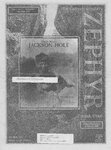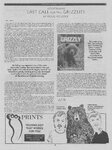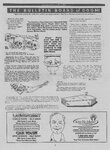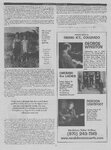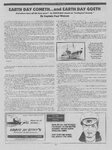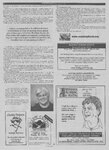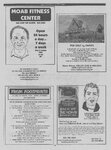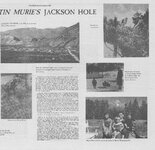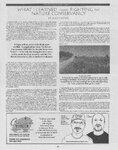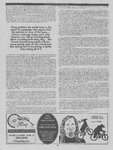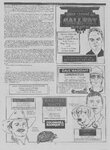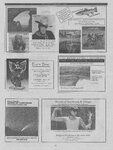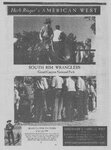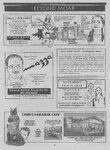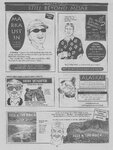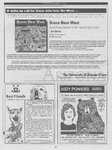| OCR Text |
Show THE ZEPHYR/JUNE-JULY 2007 MARTIN MURIE’S JACKS The view from atop Sheep Mountain, in the Gros Ventres, across Jackson Hole from the Tetons. JACKSON, WYOMING, Martin Murie was born. in the 1920s, about the time What was it like to travel to Jackson Hole in the late 1930s? These excerpts are from the ‘American Guide’ series, compiled by workers of the Writers’ program of the Works Progress Administration. The highway swings southwestward from the junction with US 287, QO m. (see Tour 5),.near a border of the Teton National Forest. Against the background of pine, lowland meadows are deep green or yellow, according to the season: JACKSON LAKE (R) is the second-largest lake in Wyoming. At 1.2 m. is the junction with a graveled road. Left on this road is MORAN, 0.1 m. (6,742 alt., 102 pop.), a tourist village aad reclamation headquarters. Tn suramer, a boat trip is made twice daily ao Jackson Lake to the base of the Tetons. "The water, generally deep and cold warmed at one place by a spring in the lake-bed. (Baaters, e fishing or ‘pleas: ure, mast report to Moran Ranger Station before embarking US 187 climbs a sharp grade to the top of ee Laxe Dam, 1.4 m., which impounds water for irrigation along the Snake River in Idaho. At 2.8 m. is the junction with a dirt road. Right on this steep and narrow road to SIGNAL eee a A Mm. (7,239 alt.), from whose summit Jackson Hole is seen in pano The n me of the mountain commemorates the sear for Robert R. anion, who lost his way while hunting In the vicinity. Searchers agreed that if Hamilton were found, a ce fire should be lighted on this summit. The body was found in Snake Riv From the ‘American Guide’ series. Coming into the town of Jackson has changed some in almost three quarters of a century... The road runs southwestward through forests of pine, with silver spruce intermingled. Groves of aspen spot the sea of dark green with pastel islands. There is much dead wood, and occasional open spaces are thickly set with gray and weathered stumps. Yellow wild flowers and grass cover the forest floor. To the northeast rise the peaks of the Continental Divide, rugged and blue, yet less austere than the Tetons, which loom ahead throdgh a haze of deep, but delicate, azure. The bases of these vast crags are robed in forest: the upper masses are sheer, frowning rock. Their summits, all just noticeably slanted in one direction, suggest the spearheads of some titanic phalanx moving into action. The road crosses a boundary of TETON NATIONAL FOREST, 5.2 m., and of JACKSON HOLE, 5.3 m, This green and fertile valley, about 400 square miles in area, extends about so miles from north to south. Its width varies from 6 to 12 miles. Snake River flows southward through the valley, while smaller streams flow in from east and west, joining the Snake or emptying into Jackson Lake. High mountains bound the valley; the Continental Divide is about 30 miles away. JACKSON, 33.2 m. (6,209 alt., 538 pop.), seat of Teton County and supply point for hunters and ranchers, has become a kind of symbol of Jackson Hole and the West. False-front and log buildings border the grassy park that forms its center. Men and women alike dress in cowboy regalia; saddle horses are usually tied along Main Street. Jackson caters especially to summer vacationists, who visit the neighboring dude-ranching and hunting areas; prices are high, because of the short summer season. The Days of "49, chiefly a rodeo, is held annually. A local winter-sports association sponsors a carnival and dog derby. A good skating rink is maintained; near-by hills afford ski and toboggan slides. Left ae i one ou, A graded road to the us a, — OF BIOLOGICAL SURVEY EFUGE, 0.51 -acre tract of mead and dathill Hoe a tee e Congress as . "wildlife. refuge. Elk, Sriginally plains animals, were driven to the mountains, as the prairies and valle vs were gradually fenced in for domestic animals. Unlike deer, elk have large fet and are unable to paw ineah ice-coated snow to uncover frozen grass uring the severe Wyoming winter of 1908-9, about 20,000 elk in "the Jackson Hole region were starving. Residents of the vailey raised a fund of $1,000 to buy hay for them, and the Wyoming State Legislature appropriated $5,000 to Se ao feed. In answer to an appeal from the Wyoming State Game — e U.S. Bureau of Biological Bieeey helped i the big herds through 2 Te ae annd in ro12 Congress set aside 1,000 acres as a winter refuge. with increased eae ee and fondione from national oO : men’s organizations, the refuge expan to its present acreage, harvested from the merddelnd ne Sinner, and additional pee e foods: including cottonseeSS are provided. The refuge now accommodates an average of about r0,coo elk. In mo2t the Elk Retuse was also made a refuge for all species of birds. At 34.9 m. is the junction with State 22. Martin's mom, Mardy Murie Martin's brother Donald, with Chimo, on Sheep Mountain in the mid-1930s. Right on this oye) road across a broad valley, with the jagged Tetons in full as oe ystacks, surrounded by tall pole fences, freckle the yellow and green of the pene floor. In every direction are ranch houses; some are spacious frame buildings with steep gables; ae are log cabins. The road crosses the NORTH FORK OF ee RIVER 2 WILSON, 5.7 m. (6,080 alt., 500 pop.), was ne for ‘Uncle Nick’ Wilson, the first settler here, whe came to Jackeo n an in 1889. Nick Loe oa childhood years among the Shoshone and was the hero of H. R. s' The White Indian Boy, or ee Nick Among de Shoshones (1919). In Wilson is the hay ae we the Grand Canyon Road (see Tour 13). The grade steepen 22 approaches the mountains and crosses 2 boundary of the TETON NATIONAL FOREST, 7.5 m. West of Lex Rancrr w (L), 8 m., is a shelf climb. The highway ascends 2,200 feet in less than = ae from one point near the top, seven hairpin turns are visible below. Tall blue pines border the road; Flank wild fldwers adorn the hillsides. Colors here seem deeper than in hg th lower country. Purple aster, goldenrod, thimbleberry, mountain ash, daisy, fireweed, heeflower, wild rose, rabbit brush, dandelion, stawherry, Indian paintbrush, purple loco, sweet clover, Indian tobacco, Rose of Sharon, and less brilliant pins grow together in a chaos of color. The bright red and gold of frost-bitten chokeberry and aspen leaves add their richness in auturnn. |
